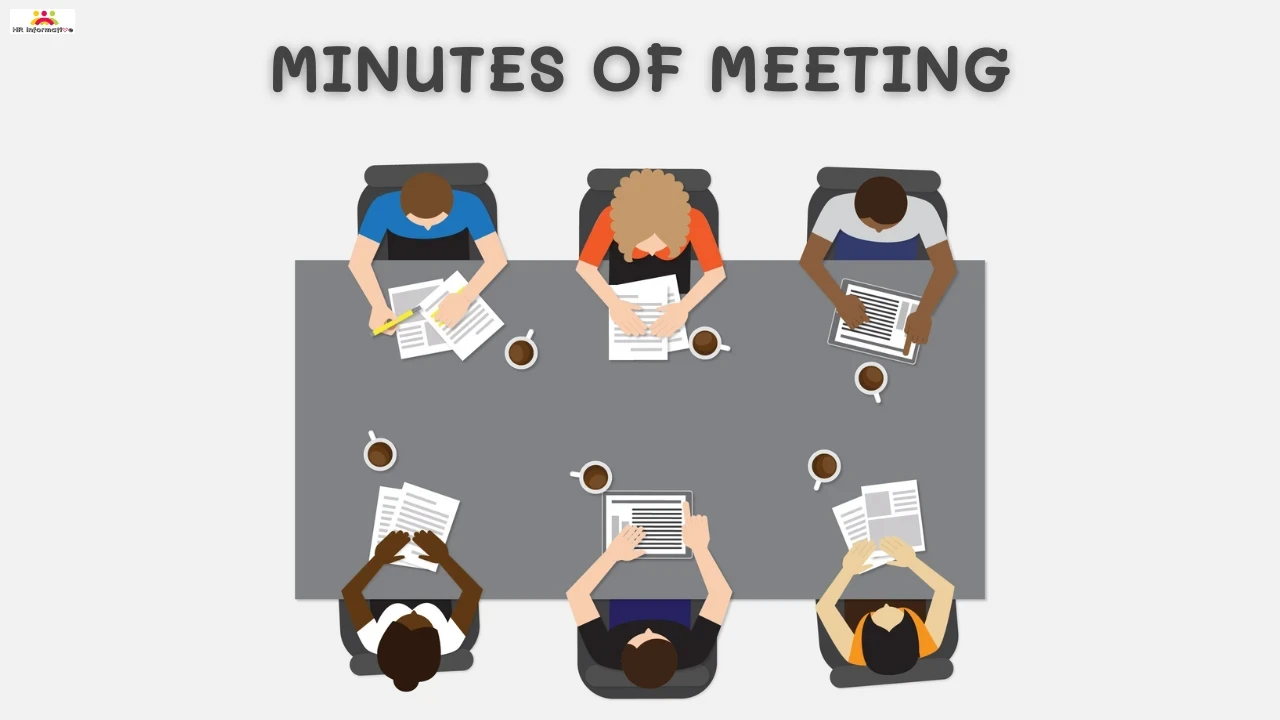Minutes of Meeting (MoM) play a crucial role in documenting discussions, decisions, and actions taken during meetings. Whether in a corporate setting, a government body, or a community organization, recording meeting minutes ensures accountability and clarity. Properly maintained MoM helps stakeholders stay informed and track progress on assigned tasks.
This article provides a detailed guide on Minutes of Meeting, including its importance, types, format, best practices, and templates to help you draft effective meeting minutes.
What Are Minutes of Meeting?
Minutes of Meeting (MoM) are written records of discussions, agreements, and decisions made during a meeting. They serve as an official reference for participants and other stakeholders, ensuring that key points and action items are documented.
MoM can be formal or informal, depending on the type of meeting and organizational requirements.
Importance of Minutes of Meeting
- Record Keeping: Provides a historical record of discussions and decisions.
- Accountability: Assigns responsibilities and deadlines to attendees.
- Clarity and Transparency: Helps all stakeholders understand what was discussed.
- Legal and Compliance Needs: Acts as official documentation in case of disputes or audits.
- Productivity Enhancement: Ensures that meetings lead to actionable results and follow-ups.
Types of Minutes of Meeting
There are different types of MoM, depending on the nature of the meeting and the organization’s requirements:
1. Action Minutes
- Focuses on key decisions and action items.
- Includes assigned responsibilities and deadlines.
- Example: “John will submit the project proposal by March 15th.”
2. Discussion Minutes
- Summarizes key discussions and viewpoints.
- Does not focus only on decisions but also on points raised by different members.
- Example: “The team debated the feasibility of outsourcing IT support, with concerns about cost and service quality.”
3. Verbatim Minutes
- Captures everything said in the meeting word-for-word.
- Often used for legal proceedings or court meetings.
- Example: “Mr. Smith stated, ‘The budget for this project must not exceed $50,000.'”
4. Informal Minutes
- A simple summary without strict formatting.
- Typically used for internal team meetings.
- Example: “Marketing and sales will collaborate on the next campaign.”
Essential Components of Minutes of Meeting
A well-structured MoM should include the following elements:
- Meeting Details:
- Date, time, and location of the meeting.
- Name of the organization or department.
- Type of meeting (weekly, monthly, annual, special).
- Attendees:
- List of participants (with designations if required).
- Names of absentees (if relevant).
- Agenda Items:
- List of topics discussed.
- Reference to any pre-circulated agenda.
- Discussions and Decisions:
- Summary of key points discussed.
- Agreements reached and decisions made.
- Action Items:
- Tasks assigned to specific individuals.
- Deadlines for completion.
- Next Meeting Details (if applicable):
- Date and time of the next meeting.
- Signature (for formal minutes):
- Signed by the Chairperson or Secretary.
How to Write Effective Minutes of Meeting
1. Before the Meeting
- Prepare an Agenda: Have a clear list of topics.
- Choose a Format: Decide on the level of detail required.
- Assign a Note-Taker: Select a responsible person for recording minutes.
2. During the Meeting
- Use a Template: This ensures consistency.
- Record Key Points: Avoid unnecessary details.
- Clarify Information: If something is unclear, ask for clarification.
3. After the Meeting
- Review and Edit: Ensure accuracy and completeness.
- Share with Attendees: Send the minutes promptly.
- Store for Future Reference: Save copies for organizational records.
Minutes of Meeting Format
Here is a standard MoM format:
Minutes of Meeting
Meeting Details
- Date: [Insert Date]
- Time: [Start Time] – [End Time]
- Location: [Meeting Venue/Online]
- Meeting Type: [e.g., Weekly Review, Project Kickoff]
- Chairperson: [Name]
- Note-Taker: [Name]
Attendees
- [Name] – [Designation]
- [Name] – [Designation]
(Include absentees if necessary)
Agenda Items & Discussions
- [Agenda Item 1]
- Summary of discussion
- Decision made
- [Agenda Item 2]
- Summary of discussion
- Decision made
Action Items
| Task | Assigned To | Deadline |
|---|---|---|
| [Task 1] | [Name] | [Date] |
| [Task 2] | [Name] | [Date] |
Next Meeting
- Date: [Next Meeting Date]
- Time: [Next Meeting Time]
Signature:
[Name]
[Designation]
Best Practices for Writing Minutes of Meeting
- Be Clear and Concise: Avoid lengthy descriptions; focus on key points.
- Use a Professional Tone: Maintain objectivity.
- Ensure Accuracy: Verify facts before finalizing.
- Share Promptly: Distribute minutes within 24-48 hours.
- Store Securely: Use cloud storage or document management systems.
Sample Minutes of Meeting
Example: Weekly Team Meeting
Minutes of Meeting
- Date: February 14, 2025
- Time: 10:00 AM – 11:30 AM
- Location: Conference Room A
- Chairperson: Mr. Rahul Sharma
- Note-Taker: Ms. Priya Mehta
Attendees:
- Rahul Sharma (Manager)
- Priya Mehta (HR)
- Amit Singh (Marketing)
- Neha Gupta (Finance)
Agenda & Discussions:
- Project Status Update
- The marketing team presented campaign results.
- It was decided to allocate an additional ₹50,000 for social media ads.
- Hiring Plan for Q2
- HR will finalize hiring requirements by February 20.
Action Items:
| Task | Assigned To | Deadline |
|---|---|---|
| Submit campaign performance report | Amit Singh | Feb 18, 2025 |
| Finalize hiring plan | Priya Mehta | Feb 20, 2025 |
Next Meeting: March 5, 2025, at 10:00 AM
Signature:
Rahul Sharma
Manager
Final Thoughts
Minutes of Meeting are essential for effective communication, decision-making, and accountability in any organization. By following a structured format and best practices, you can ensure that meetings lead to productive outcomes. Whether for internal discussions or legal purposes, a well-documented MoM helps in maintaining transparency and efficiency.
If you’re responsible for writing meeting minutes, use the provided templates and examples to create professional and effective records.
Explore More :



